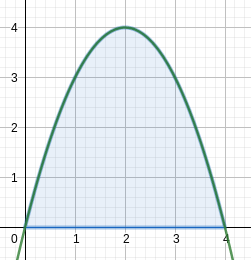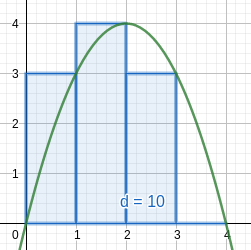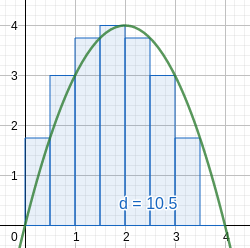MTH252
Notes on Integration
Winter 2019
Chapter 4 from Calculus 1
§ 4-10 Antiderivatives
If the derivative is `2 x`, then what is `f(x)`?
I think it could be `f(x)=x^2+1`.
List antiderivatives for each of the following functions:
- `5x^4`
- `x^2-5x+1`
- `sin(x)`
- `sec^2(x)`
- `e^{3x}`
- `1/x`
- `sqrt(x)`
- `1/(1+x^2)`
§ 1-1 Approximating Areas
Consider the image below:

Positive area under a curve.
How do we find such an area?



Rectangles are easy to work with.
Summation Notation
`sum_{i=1}^{20} i = 1+2+\cdots +19+20`
- Left Sums
- Right Sums
- Upper Sums
- Lower Sums
- Summation Rules
- Constant
- sum/difference
- Multiple
Riemann Sums
`A~~sum_{i=1}^{n} f(x_i^\*) \Delta x`
Problems
Find the indicated area:
- `f(x)=x^2` on `[0,4]`, 4 rectangles with left end-points
- `f(x)=1/x` on `[0,4]`, 4 rectangles with right end-points
- `f(x)=4x-x^2` on `[0,4]`, 4 rectangles with an upper sum
- `f(x)=sin(x)` on `[0,pi]`, 6 rectangles with an upper sum and a lower sum.
- `f(x)=x^2` on `[0,4]`, 8 and 16 rectangles with a right sum
- `f(x)=x` on `[0,1]`, 100 rectangles with an upper sum